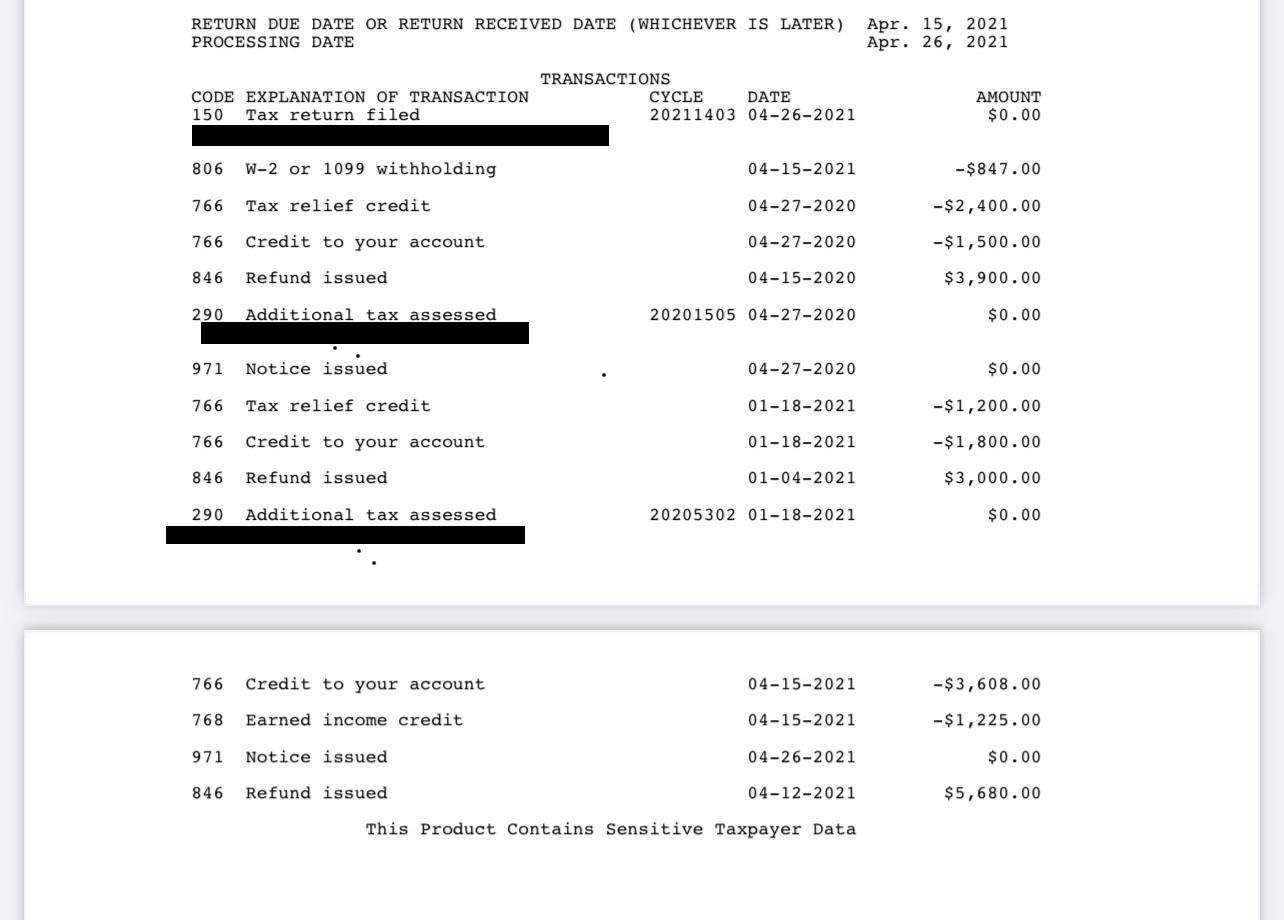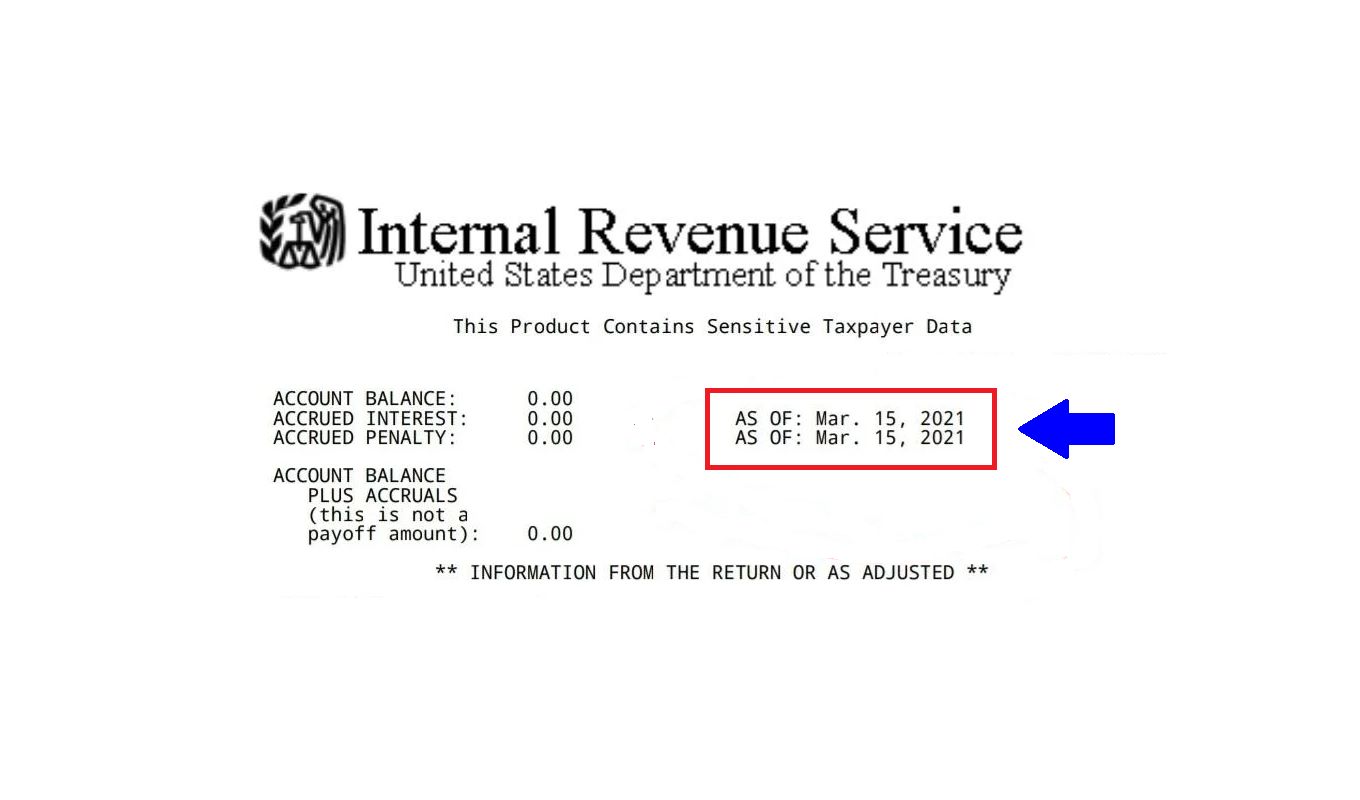

Finance
What Is Code 766 On An IRS Transcript?
Published: October 31, 2023
Discover the meaning of code 766 on an IRS transcript and its significance in the world of finance.
(Many of the links in this article redirect to a specific reviewed product. Your purchase of these products through affiliate links helps to generate commission for LiveWell, at no extra cost. Learn more)
Table of Contents
Introduction
In the complex world of finance and taxes, it is not uncommon for taxpayers to encounter unfamiliar terms and codes. One such code that may appear on an IRS transcript is code 766. Understanding what this code represents and its implications is crucial for taxpayers to navigate their financial obligations effectively.
IRS transcripts are detailed records of a taxpayer’s financial activities, including tax returns, payments, and other important information. These transcripts are used by the IRS to assess taxpayers’ compliance with tax laws and to ensure accurate reporting of income, deductions, and credits.
Code 766 on an IRS transcript is a specific indicator that signifies a particular action or event that has occurred within a taxpayer’s account. While it may not always be cause for alarm, it is essential to investigate the reason behind code 766 to address any potential issues or concerns.
In this article, we will explore the meaning of code 766 on an IRS transcript, examine common reasons for its appearance, discuss the potential impact on taxpayers, and provide guidance on resolving any issues that may arise.
Explanation of IRS Transcripts
Before diving into the specifics of code 766, it’s important to have a basic understanding of IRS transcripts and their purpose. An IRS transcript is a documented record of a taxpayer’s tax-related activities and interactions with the IRS. It provides a historical overview of key events, such as tax return filings, payments, penalties, and adjustments.
IRS transcripts come in different types, each serving a different purpose:
- Return Transcript: This transcript provides a summary of the taxpayer’s original tax return, including information regarding filing status, income, deductions, credits, and tax liability.
- Account Transcript: An account transcript displays records of various transactions and activities associated with the taxpayer’s account, such as payments, penalties, and changes made by the IRS.
- Wage and Income Transcript: This transcript shows reported income from employers, financial institutions, and other sources.
- Record of Account Transcript: This comprehensive transcript combines information from various other transcript types to provide a comprehensive overview of the taxpayer’s account.
These transcripts are valuable tools for taxpayers, tax professionals, and the IRS itself. They enable individuals to verify their tax history, confirm received payments, identify errors, and address any potential discrepancies or issues that may arise.
Now that we have a solid understanding of IRS transcripts, let’s delve into the specifics of code 766 and its significance within these records.
Understanding IRS Code 766
IRS code 766 is a transaction code that may appear on an IRS transcript. This code indicates a specific action or event that has taken place within a taxpayer’s account. While the exact meaning can vary depending on the circumstances, code 766 generally refers to the issuance of a refund offset.
A refund offset occurs when the IRS uses all or a portion of a taxpayer’s tax refund to satisfy certain unpaid debts. These debts can include outstanding federal or state tax liabilities, past due child support payments, defaulted student loans, or other legally mandated obligations.
The IRS typically notifies taxpayers in advance when a refund offset is going to occur. They send a Notice of Intent to Offset Refund (CP 49) to inform the individual of the amount being withheld from their refund and the reason for the offset. The taxpayer is given an opportunity to contest the offset if they believe there has been an error or if they wish to enter into a payment arrangement to address the debt.
It’s important to note that code 766 is not limited to refund offsets alone. In some cases, it may also indicate other actions or events related to a taxpayer’s account, such as the application of an overpayment to an outstanding balance or a refund generated from an amended return.
In order to fully understand the implications of code 766 on an IRS transcript, it is essential to review the specific details provided in the transcript and any accompanying correspondence or notices from the IRS.
Now that we have a clearer understanding of IRS code 766, let’s explore some of the common reasons why it may appear on a taxpayer’s transcript.
Common Reasons for Code 766 on an IRS Transcript
When code 766 appears on an IRS transcript, it can be attributed to various reasons. While the specific cause can vary depending on the individual taxpayer’s circumstances, there are a few common explanations for this code:
- Refund offset: The most common reason for code 766 is a refund offset. As mentioned earlier, this occurs when the IRS withholds all or a portion of a taxpayer’s refund to satisfy outstanding debts, such as unpaid taxes, child support arrears, or defaulted student loans.
- Overpayment applied: In some cases, code 766 can indicate that an overpayment from a previous tax year has been applied to the taxpayer’s account to offset an outstanding balance. This means that any surplus amount that was initially intended as a refund will be used to reduce the overall debt owed.
- Amended return refund: Code 766 may also appear if a taxpayer has filed an amended return and is eligible for a refund due to changes in their tax liability. This code indicates that the IRS has issued the refund resulting from the amended return.
- Taxpayer advocate involvement: In certain instances, code 766 can be related to the intervention of a taxpayer advocate. Taxpayer advocates are independent officials within the IRS who assist taxpayers with resolving complex tax issues. If a taxpayer’s case has been referred to a taxpayer advocate, code 766 may appear on the transcript to indicate their involvement.
If code 766 appears on your IRS transcript, it is crucial to review the accompanying details to verify the specific reason for its appearance. This may involve reviewing any notices or correspondence from the IRS or contacting them directly for clarification.
Now that we understand the common reasons behind code 766, let’s explore the potential impact it can have on taxpayers.
Impact of Code 766 on Taxpayer
When code 766 appears on an IRS transcript, it can have several implications for the taxpayer. Understanding the potential impact is crucial in order to address any financial repercussions and take appropriate action. Here are some key points to consider:
- Refund reduction: If code 766 is due to a refund offset, the taxpayer can expect a reduction in their expected refund amount. The IRS will use the withheld funds to satisfy outstanding debts, such as unpaid taxes or other financial obligations.
- Delayed refund: In cases where a refund offset is involved, the taxpayer may experience a delay in receiving their refund. The offset process can take some time to complete, and it may take additional weeks or months before the remaining refund (if any) is issued.
- Debt resolution: For individuals with outstanding debts, code 766 can serve as a reminder or catalyst to address their financial obligations. It may prompt them to take corrective action, such as setting up a payment plan or negotiating a resolution with the IRS or the respective agency responsible for the debt.
- Financial planning: The appearance of code 766 on an IRS transcript can serve as a wake-up call for taxpayers to review their financial situation and practices. It may prompt them to take steps to improve their financial management, such as budgeting, reducing unnecessary expenses, or seeking professional advice.
- Tax compliance: Code 766 can serve as a reminder of the importance of tax compliance. It underscores the need to accurately report income, deductions, and credits, as well as promptly address any outstanding tax liabilities or debts to avoid future complications.
It is important for taxpayers to carefully review their IRS transcripts, notices, and other relevant information to fully understand the impact of code 766 on their specific situation. If there are any concerns or discrepancies, it is advisable to reach out to the IRS or consult a tax professional for guidance.
Now that we are aware of the potential impact of code 766, let’s discuss how taxpayers can go about resolving any issues related to this code.
Resolving Issues Related to Code 766
If you encounter code 766 on your IRS transcript and believe there may be an error or if you need assistance in addressing the underlying issue, here are some steps you can take to resolve the matter:
- Review the IRS notice: Carefully read any notices or correspondence related to the code 766. The notice should provide details on the reason for the refund offset or other actions taken by the IRS. Make sure to review the information for accuracy and understand the steps you need to take.
- Contact the IRS: If you have questions or need clarification regarding code 766, consider reaching out to the IRS directly. You can contact the IRS at the phone number provided on the notices or visit their website for additional contact information. Be prepared to provide your taxpayer identification number and any relevant information regarding your case.
- Seek professional assistance: If you are unsure how to proceed or believe you require expert guidance, it may be beneficial to consult a tax professional. They have the expertise to navigate complex tax matters and can provide personalized advice tailored to your specific situation.
- Address outstanding debts: If code 766 is a result of a refund offset due to unpaid taxes or other debts, it is crucial to address those obligations promptly. Contact the appropriate agency responsible for the debt and explore options for payment plans or debt resolution. Taking proactive steps to resolve outstanding debts can help prevent future complications.
- Consider a taxpayer advocate: If you have been struggling to resolve your tax issue or believe you are facing undue hardship, you may qualify for assistance from a taxpayer advocate. Taxpayer advocates are independent individuals within the IRS who can help navigate complex cases and ensure your rights as a taxpayer are protected. You can contact the Taxpayer Advocate Service (TAS) to determine if you qualify and request their assistance.
Resolving issues related to code 766 requires patience, persistence, and a proactive approach. It is essential to gather all relevant documentation, maintain open communication with the IRS or other agencies involved, and seek professional assistance when needed.
By taking the necessary steps to address the issue, you can work towards a resolution and ensure your financial obligations are appropriately managed.
Now, let’s wrap up our discussion.
Conclusion
In summary, code 766 on an IRS transcript is a significant indicator that represents various actions or events within a taxpayer’s account. Understanding the meaning of this code, its potential impact, and how to address any related issues is crucial for individuals navigating their tax obligations.
IRS transcripts serve as valuable records that provide a comprehensive overview of a taxpayer’s financial activities. Code 766 commonly appears when there is a refund offset, where the IRS withholds a portion or the entirety of a taxpayer’s refund to fulfill outstanding debts.
The appearance of code 766 can have implications such as reduced or delayed refunds, debt resolution requirements, and the importance of tax compliance and financial planning. It is crucial for taxpayers to review their IRS transcripts and any accompanying notices to understand the specifics of code 766 in their situation.
To resolve issues related to code 766, taxpayers should review IRS notices, contact the IRS for clarification, consider seeking professional assistance, address outstanding debts promptly, and explore assistance from taxpayer advocates if necessary.
By taking the necessary steps to address any issues connected with code 766 on your IRS transcript, you can work towards resolving the matter and ensure compliance with tax laws. It is important to stay proactive, maintain proper communication, and seek professional advice where needed.
Remember, navigating the world of finance and taxes can be complex, but by understanding the meaning of codes such as code 766, you can manage your tax obligations effectively and ensure a smoother financial journey.
Thank you for reading this article, and we hope it has provided you with valuable insights into IRS code 766 and its implications on taxpayers.














